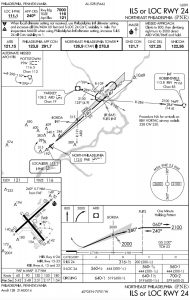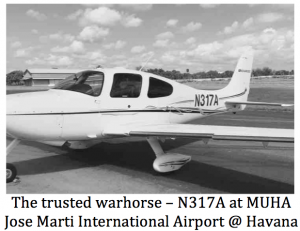Fifteen-hundred-for-eight-hundred.
One-thousand-for-eight-hundred.
Down to eight hundred feet. Our altitude is eight hundred feet! We are just about five hundred feet above ground. And it is still milky white outside the cockpit. Fog and Clouds.
No runway, or runway markings, or runway lights, or runway end indicator lights.
Nothing.
My pulse quickens. I know I have sweaty palms. I am in one of the toughest situations of my amateur career as a pilot, and I have my family on-board.
How did we get here?
EIGHT HUNDRED! That’s the minimum altitude I could safely descend to. Still no joy finding the runway. Full power. Go ‘missed‘. Climb and begin the missed approach procedure.
Me to Philly Control: November-Three-One-Seven-Alpha is going missed.
Philly Control: November-Three-One-Seven-Alpha. Roger. State your intentions.
I could sense everyone stiffening up in the plane as soon as the engine roared back to life and the plane started its climb back to a safe altitude. Besides, they had their headsets on, so they heard every word of my exchange with the controller.
So this is what they tell you to avoid. Get-there-itis. This is what it is like.
They warn you about it. They tell you it creeps up on you silently, and hits you like a sledgehammer as the realization dawns on you that you are in a ‘situation’.
Should we launch or not?


I have faced this dilemma many times over the years at work, as we are facing one now. Our product is ready. Should we launch, release, get to market or wait, test, re-ascertain, establish, verify, validate, research, consult some more?
Are we being impatient? Like the time we released a notification capability that had a bug, and it sent out a notification every minute. This was rolled out on a Friday evening. Over three thousand reminders greeted users when they fired up their computers on Monday morning. It took us time to live that down!
Or will we be late? As was the case in late nineties when we waited too long to launch a new product and the market structure changed drastically resulting in substantial losses for us.
The two points of view…
At that time as at others, there have always been competing views in our team on whether the time is right for launch or not. How do we decide whether the time is right to move ahead? Should we invest the time, money, expense and effort in taking something new to market?
The cautious counsel moving gingerly. Test the product some more they say. Add one more feature here. Improve that other feature over there. The ‘Dear Prudents’.


There is no perfect product. The market will redefine your product. The only relevant feedback is the one that you receive from the actual users of your product, not what you dream of in your ivory towers. You have to put it out there and let the market take a look at it. That’s what the ‘Gun-Slingers’ tell you.
Both these points of view make sense. The questions are – how do we determine whether we should proceed? Where do we draw the line between going and staying? How can we move ahead, but with caution, make sure we have considered everything that can be foreseen?
What can we do before we launch?
We had stopped in Norfolk on our way back from Florida the previous afternoon for fuel and food. A quick check showed lowering weather across our route. It was about 3 PM. About an hour and a half from Wings airfield made it an ETA of about 4:30 PM. This was in December, so it would be dark by the time we got there. As I was weighing the pros and cons of continuing the flight from Norfolk, Samaya, my older daughter chimed in and advised caution. That was good advice. Reducing daylight, lowering weather and visibility, late in the day, tiredness were all factors compounding the situation. So we found a hotel room and turned in for the night.
We woke up to clear skies over Norfolk. I checked the weather. There was a warm front halfway across our route in the Northern Chesapeake bay area. It was expected to be clear for the first half of our route. Our destination – Wings airfield, had clouds but nothing I could not handle. Cloud bases were about one thousand feet above ground. Well above ‘my minimums’. Icing was not a factor. And I was feeling fresh after a nights rest. I decided to press on.
Do we have a backup plan?
I had a plan B and a plan C in case the weather at our destination was not what it was forecast to be when we got there. What if the weather went below my minimums while we were en-route?

Plan B was to go to another airport nearby. Philadelphia North East – PNE, in this case. I was very familiar with PNE as I had done most of my training when based at this airport. This – giving an alternate airport, is
I was comfortable with Philadelphia North East also because it had a precision approach – that meant I could come closer to ground – just two hundred feet above the runway, giving me better odds of seeing the runway and landing in case the weather deteriorated at Wings.
Plan C was to turn back to Norfolk where the weather was all clear and forecast to be so for the whole day. I had about five hours of fuel on board, and it was only a one and half hour flight. So if the weather deteriorated significantly on reaching Wings airfield I could easily make it back to Norfolk, land and wait out the weather.
We have been working on some new capabilities that add to one of our products. The impulse to launch is strong. We have spent our treasure and time building, testing, refining. Some of us feel we are ready to go, others want to make everything a little more perfect. The question we are faced with is whether we should move ahead or stay put?
OK. What happens if we do launch?
How should we decide what to do? What criteria should I use? I looked for ideas from that flight.
Was the plane ready for the flight? Yes, I had equipment necessary for foreseeable emergencies on board. Is the product ready?
Was I ready for the flight? Yes, I was rested, feeling good and had the reserves of energy to deal with a challenge should one arise. Is the team ready?
Did I know what to expect? Yes, I got a weather briefing. Have we discussed the different scenarios that we can expect?
Was I capable of handling the expected conditions? Yes, the weather was well above my personal minimums, well within the levels of my training, competence, and current capabilities. Do we have the necessary resources available to handle the release?
Did I have a back-up plan in case things went wrong? Yes, I had a plan B, and since a lot was at stake – my family was on board, I had a plan C. What do we do if things go wrong?
We had launched! And it got me into one of the toughest situations I had been in till then. And, it had to have happened with my family on board.
No. It did not just happen. I was responsible for every decision in the chain of events that brought us to that point in time.
What now?
We had departed Norfolk in clear bright skies, and as expected passed the front somewhere over Salisbury. We flew on in clear skies a couple of thousand feet above a solid overcast layer of clouds. Everything was going well till we got down to minimums over Wings.
We did not find the runway at Wings.
Philly: November-Three-One-Seven-Alpha. Roger. State your intentions.
Me: November-Three-One-Seven-Alpha would like ILS two-four at Papa-November-Echo (PNE)
Philly: November-Three-One-Seven-Alpha. Roger. Expect ILS two-four @ PNE. Turn three-zero-zero for vectors to final. Two thousand feet.
The controller must have detected that faint tremor in my voice, because she made it easier for me by vectoring me to the final course, instead of having me navigate by instruments to the final course. It eased my workload at a crucial time.
Once on the final course, the pressure eased somewhat. I was in familiar territory. I knew the ILS 24 approach like the back of my hand as I had flown it hundreds of times during my training.
We, all four of us, saw the runway at the same time just as we got down to the minimums at an altitude of about five hundred feet. We all yelled and pointed, and I stuck the plane in there! The relief was palpable. It turned out well. With very perceptive and timely help from that controller.
Prepare. Have backups.
In taking inspiration from that flight we have spent some more time testing the product – we are rested for the flight.
The product is ‘ready-er’ than it was – the plane is ready for the flight.
Our product team has the right mix of people – from technical, operations, support, marketing and sales functions – we are ready for the flight.
We have imagined some scenarios and tried to plan for them. What happens if there is wild growth in usage and the infrastructure capacity blows up? Or we get hacked? What happens if the product usage fails to pick up? How do we determine where the point of failure is? Is it in the product? Or operations and support? In our sales strategy? Or our marketing message? Yes to all of them – We got our briefing.
How do we handle different scenarios? We are capable of handling the expected conditions.
And put money and treasure aside and laid our markers so that we know how long to persist before we go to our ‘alternates’? We have decided on our minimums.
We have put in place a Plan B. What resources to manage, control, reallocate, reduce as we cross different markers in our quest. I do not think we have a Plan C though – a thought that makes me uncomfortable. We think we know what to do if things go wrong.
Take help when it is offered
Despite all this preparation, I still have an unanswered question, a niggling thought in the back of my head. Do we have air traffic controllers out there who can provide that crucial assist if we need one?
I don’t know how this will turn out. We have made that decision to go, and our product is launched. But it is early days yet, we are still on the taxiway at Norfolk. I will keep you posted on how this goes. Meanwhile if you have any thoughts, tips on things I may be missing or could do, please write back to me or comment on this blog. I may be the pilot in command but you could be that air traffic controller. I could use your help.
I have my seat belts on. And the shoulder harness.





